|
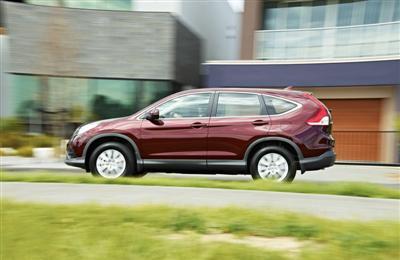 Honda CR-V VTi 2WD
Honda CR-V VTi 2WD
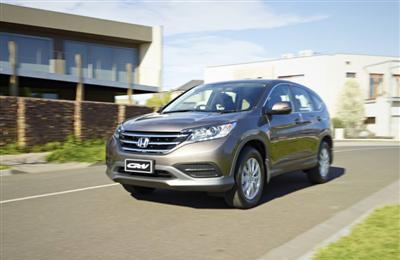 Honda CR-V VTi 2WD
Honda CR-V VTi 2WD
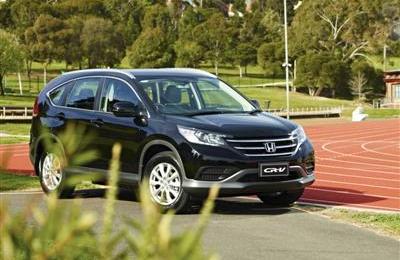 Honda CR-V VTi 4WD
Honda CR-V VTi 4WD
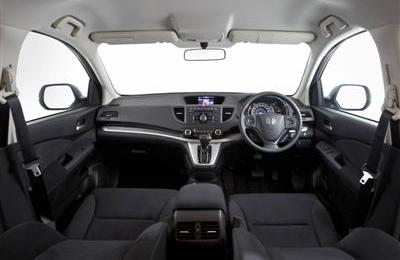 Honda CR-V VTi 4WD
Honda CR-V VTi 4WD
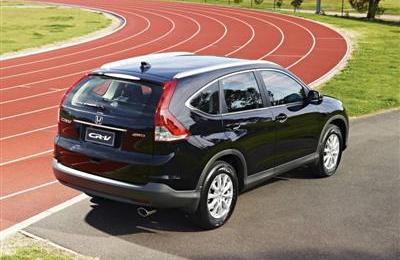 Honda CR-V VTi 4WD
Honda CR-V VTi 4WD
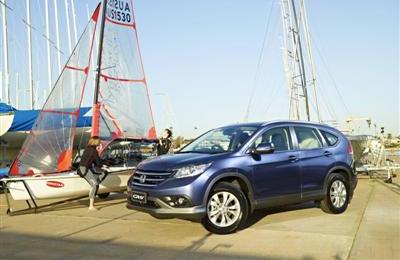 Honda CR-V VTi-S 4WD
Honda CR-V VTi-S 4WD
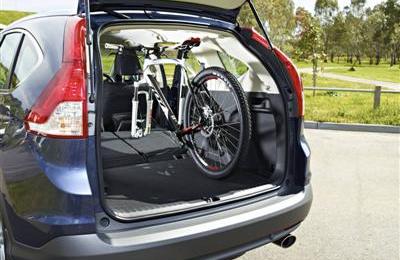 Honda CR-V VTi-S 4WD
Honda CR-V VTi-S 4WD
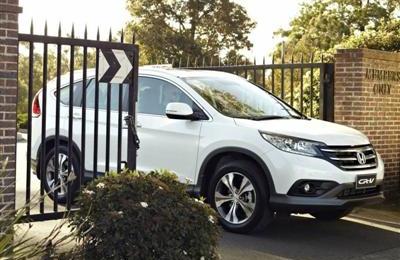 Honda CR-V VTi-L 4WD
Honda CR-V VTi-L 4WD
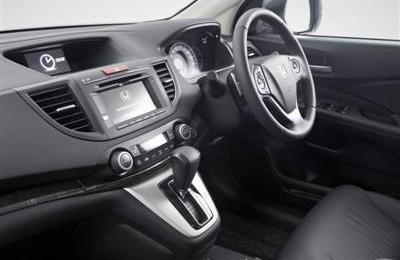 Honda CR-V VTi-L
Honda CR-V VTi-L
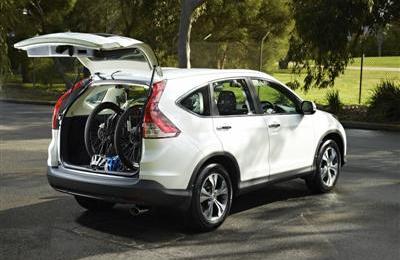 Honda CR-V VTi-L
Honda CR-V VTi-L
Prices*
CR-V 2WD VTi manual - $27,490*
CR-V 2WD VTi auto - $29,790*
CR-V 2WD VTi auto - $31,790* (with navigation)
CR-V 4WD VTi auto - $32,790*
CR-V 4WD VTi-S auto - $36,290*
CR-V 4WD VTi-L auto - $42,290*
|
|
|
Fourth-generation Honda CR-V released
Home >
News >
Honda
Recent new car releases ..... here
Upcoming new car releases ..... here
13th January, 2013
Some 133,000 Honda CR-Vs have been sold in Australia since 1997, making it
quite a popular mid-size SUV. The new fourth-generation model of the successful Honda CR-V was released locally prior to
last Christmas.
Like many of its competitors, the all-new CR-V is now available in both two-wheel and four-wheel drive
configuration. Prices* begin at $27,490* for the 2WD manual and $32,790* for the 4WD auto.
The two-wheel drive version is powered by a 2.0-litre i-VTEC petrol-fuelled engine delivering 114 kW @ 6,500 rpm and
190 Nm of torque @ 4,300 rpm with a six-speed manual as standard, A five-speed automatic transmission is optional.
The four-wheel drive version has a 2.4-litre engine delivering 140 kW @ 7,000 rpm and 222 Nm @ 4,400 rpm with a
five-speed automatic transmission as standard.
Three trim levels are on offer. Namely, VTi, VTi-L and VTi-S.
Pedigree
Over five and a half million CR-Vs have been sold across the world since its introduction in 1995 and the new
fourth-generation builds on the success of its predecessors with even greater quality, practicality and refinement. The
model that helped define the compact-SUV sector has been comprehensively redesigned for the global market.
For the first time in Australia, the CR-V will be offered with a choice of both two- and four-wheel drive.
Improvements to the 2.4-litre engine have resulted in better fuel economy and significant reduction in CO2 emissions.
The all-new Honda CR-V for the Australian market is manufactured in Thailand.
Ryouji Nakagawa, the Large Project Leader (LPL) for the CR-V commented: “The first-generation set out to combine
the best elements of a car and an SUV. For the new CR-V, we have now achieved a perfect, centred balance between the
efficiency of a car and the functionality and security of an SUV. In doing so, we have created a model that is efficient,
versatile and capable.”
Exterior Design
• Reduced height and length without compromising interior space
• Sedan-like driving position
The pursuit of the perfect balance between a car and an SUV influenced every element of the development process,
including the exterior styling. Exterior Designer Manabu Konaka explains: “The CR-V has always been a car for every
occasion. It can be both casual and formal, but the aesthetic must always convey solidity and reliability.”
The length of the car has been reduced by 20 mm while the height (measured without the 'shark fin' antenna) has been
reduced by 30 mm compared with the outgoing model.
There has been no change to the interior space. “This is only one example of the new CR-V’s improved
efficiency,” says Konaka. “This is a functional, efficient and confident car and we’ve tried to express that in
the design.”
While the fourth-generation model is instantly recognisable as a "CR-V", it still manages to assert its own identity.
The new model takes on a more aggressive and aerodynamic stance with deeper sculpting of the bodylines and a bolder nose
section. The front bumper’s smooth, flowing lines are joined by a horizontal three-bar grille and deep-set headlights.
The signature vertical rear brake lights, which have featured on every generation of CR-V, remain but the
fourth-generation introduces a more three-dimensional style. The CR-V’s large wheels and bold wheel arches further
emphasise its presence and capability.
The position of the windscreen has been brought forward by 60 mm (measured from the bottom of the windscreen) relative
to the overall length of the car. As a result, the size of the engine compartment has been reduced. “At Honda, every
project leader pursues our man-maximum, machine-minimum philosophy,” says Nakagawa. “It is always our goal to
reduce the size of the mechanical parts in order to provide more space for the occupants. It is a big challenge for our
engineering and production teams, but one that we must take on.”
The repositioning of the windscreen and the new bonnet design provided a second benefit – the area of the nose of the
car that cannot be seen from the driver’s seat has been reduced to improve visibility and make the CR-V easier to
manoeuvre.
A 10 mm increase in both the steering wheel and seat height adjustments ensures a broader range of drivers can achieve
an ideal driving position.
The synergy between form and function has played a critical role in the development of every generation of the Honda
CR-V and this latest model is no exception. The expansive glass area reveals the spaciousness of the cabin. Konaka says;
“I am particularly proud of the rear window design. We wanted to extend it to the edge of the vehicle to emphasise the
sleek proportions and this also had the advantage of increasing boot space.”
With the rear seats folded flat, the boot capacity of the CR-V has grown by 147 litres to 1,648 litres and the floor
length has been increased by 140 mm to 1,570 mm. The load height has been reduced to 665 mm, making it easier to load
heavy or awkward items.
Interior Design
• Ergonomically efficient spacious interior
• High quality finish
• NVH improvement
• Five inch i-MID
• Easy fold-down one motion 60/40 split rear seat
The interior design concept for the new CR-V continues the man-maximum, machine-minimum philosophy. “The first
thing that we wanted to achieve with the interior design was a feeling of openness,” says Interior Designer, Takehiro
Ishibashi. “I wanted to communicate the feeling you get when you stand on top of a mountain, looking down on the
valley and seeing a panorama of the landscape. It’s a feeling of freedom, space and timelessness.”
The influence of this thinking can be seen in the fascia design. “There are a number of horizontal layers which
help emphasise the feeling of space,” says Nakagawa. “We call this ‘lean-layered’ design. By arranging the major
functions in a series of layers, you create an ergonomically-efficient environment that is very intuitive.” The major
controls have been further grouped according to their function, with a ‘driver interface zone’ behind the steering wheel
and an ‘information interface zone’ in the centre of the cabin.
Care has also been taken to achieve a significant reduction in the engine and road noise entering the cabin. Sound
insulation material has been applied to the floorpan below the passenger compartment, while sound absorption material has
been fitted to the rear door, rear wheel arches, door frames, front bulkhead and bonnet. The doors also now feature a
double seal. The result is a reduction in cabin noise compared to the current CR-V.
This quality ambience is further enhanced by an impressive range of equipment. In the cabin, attention focuses on the
five-inch i-MID, which displays the audio and hands-free Bluetooth phone systems (where fitted). Also fitted as standard
are Honda’s acclaimed ECON mode, which assists the driver to minimise fuel consumption and Eco Assist system, which
advises drivers on how their driving style is impacting on fuel economy.
In order to emphasise the feeling of space inside, the door casings have been sculpted to provide a concave shape.
This has also allowed the occupants of the front seats to be moved closer to the sides of the car, making it easier to
step in and out. As a result, more space has been liberated between the seats for a centre console that houses three cup
holders, a storage compartment, an armrest and air vents for the rear seats.
The hip point of the rear passenger seats has been lowered by 38 mm compared to the current model, resulting in
increased headroom. A change in the design of the rear seats has also allowed Honda’s engineers to introduce easy
fold-down 60/40 Split Rear Seats, which can be folded flat in one movement. At the pull of a handle, the CR-V can be
transformed from a five-seat passenger car into a versatile load-lugger. “This is a feature of which I am particularly
proud,” says Ishibashi. “It will make a big difference to how our customers use their CR-V.”
Efficiency
• Improved aerodynamics
• Choice of 2.0 litre and 2.4 litre i-VTEC engines (two and four-wheel drive respectively)
• Improved fuel economy for the 2.4-litre engine of 13 per cent while reducing emissions by 15 per cent
• ECO Assist and ECON Mode
The CR-V has always been one of the most efficient SUVs on the market and Honda’s engineers have worked tirelessly to
hone every aspect of this new fourth-generation model.
Improved aerodynamics and sophisticated electronics combine to achieve significant reductions in fuel consumption and
exhaust emissions.
Aerodynamics
As with so many elements of the new CR-V, form and function go hand in hand in the aerodynamics of the car. The
adoption of a flat under floor and sculptured wheel arches have smoothed the air flow under the car, while a longer roof
combined with an aerodynamically optimised front bumper help to manage the air-flow over the body. The result is a
reduction in the drag coefficient of 8 per cent compared with the current CR-V, benefitting performance, fuel economy and
reducing exhaust emissions.
Engines
Under the bonnet of the new Honda CR-V, customers will find either a 2.0-litre or a 2.4-litre i-VTEC petrol engine.
“We have placed a key emphasis on applying new technologies to reduce the friction in the engines and improve their
efficiency,” explains Nakagawa. Improvements in fuel economy and a reduction of CO2 emissions in the new CR-V have
been achieved without compromising driving pleasure.
The power output of the 2.0-litre i-VTEC engine is 114 kW at 6,500 rpm and 190 Nm of torque at 4,300 rpm. For the
manual transmission, fuel economy is 7.8 litres per 100km (combined urban/extra urban) with CO2 emissions of 182g/km. For
the automatic, fuel consumption is 7.7 litres (combined urban/extra urban), with CO2 emission of 179g/km.
The 2.4-litre engine delivers 140 kW at 7,000 rpm and 222 Nm at 4,400 rpm.
Fuel consumption for the automatic transmission is 8.7 litres per 100 km with CO2 emissions of 201 g/km.
The CR-V’s engines use Honda’s long established VTEC system, which is able to adjust the lift and opening duration of
the valves. The system is complemented by Variable Timing Control (VTC), which monitors the engine load and controls the
phasing of the inlet camshaft. These work together to produce a remarkably broad and smooth power band. Based on input
from a position sensor located at the rear end of the inlet camshaft, the engine’s ECU varies the inlet camshaft position
relative to that of the exhaust camshaft. In this way it can advance and retard the opening of the inlet valves.
During acceleration, VTC is set at a relatively small degree of valve overlap to provide the optimal output, with the
valve opening angle using the inertia of the intake air. In addition, as engine speed builds, the VTEC mechanism switches
from the low speed cam to the high speed cam, but with the same degree of overlap. At high engine speeds, there is much
greater valve overlap, which reduces pumping losses, maximises exhaust gas recirculation and provides the best balance
between fuel consumption and power output.
At idle and low engine speeds during light load conditions, inlet valve opening is retarded for minimal overlap,
generating strong swirl and therefore stable combustion.
ECON Mode
The new CR-V is equipped with an ECON button as part of Honda’s Eco Assist™ system. When activated, ECON mode alters
the mapping of the drive-by-wire throttle system to ensure a smooth increase in torque and greater fuel economy. In
addition, it alters the operation of the cruise control and the air conditioning systems, allowing for slightly increased
variances with the set speed or the set temperature in order to conserve fuel whenever possible. For all models, the air
conditioning controls the compressor and decreases the voltage of the fan drive to reduce the load on the engine,
improving fuel efficiency.
ECO Assist
When Honda developed the second-generation Insight hybrid model, engineers discovered that different driving styles
could make as much as 21 per cent variance in fuel economy. In response to this they developed ECO Assist, which helps
drivers optimise their driving efficiency. It uses the car’s speedometer to advise how driving style is impacting fuel
economy. If the driver slightly exceeds the best level of throttle control, the ambient light will illuminate light
green. Finally, it will glow white during heavy acceleration and deceleration. The system coaches the driver to improve
their efficiency.
Ride Comfort and Handling
• Almost sedan-like handling
• McPherson strut front and multi-link rear suspension
• Bending rigidity up 7 per cent
• Torsional rigidity up 9 per cent
• Six-speed manual (two-wheel drive only) or five-speed automatic transmission
• Motion Adaptive EPS steering system (MA-EPS)
The all-new Honda CR-V marks the introduction of a two-wheel drive model in Australia as well as upgrades to the car’s
suspension and steering.
Suspension
The MacPherson strut front and multi-link rear suspension systems have been upgraded with an increase in damper
volume. An increase in the body’s rigidity – bending rigidity is up 7 per cent and torsional rigidity up 9 per cent –
allows the suspension to operate more effectively.
The front suspension has been designed to be compact, while delivering the wheel travel necessary to provide off-road
versatility and a comfortable ride.
The McPherson strut front suspension consists of a sub-frame attached lower control arm and wheel hub connected to a
damper and coil spring assembly. Specially tuned bushings and precisely calibrated suspension geometry ensure optimal
ride, handling and steering feel in a wide variety of road conditions.
The Honda CR-V is equipped with a rear independent multi-link suspension system with an aluminium knuckle, designed to
optimise ride and handling while maximising cargo space. The three-link system uses large-diameter trailing-arm bushings
to reduce harshness and improve ride comfort.
All models feature front and rear anti-roll bars to reduce body roll during cornering. The diameter of the tubular
front bar measures 20 mm and the solid rear bar measures 19 mm.
Six-Speed Manual Transmission (Two-Wheel Drive VTi only)
Honda’s gearboxes have always been renowned for their slick, positive action.
The new CR-V is available with a compact and lightweight six-speed manual transmission for the two-wheel drive VTi
only.
Five-Speed Automatic (standard in Four-Wheel Drive)
The CR-V is also available with a five-speed automatic transmission with Grade Logic Control and the four-wheel drive
variants have paddle shift. This sophisticated torque converter automatic delivers near-seamless shifts yet retains good
throttle response and a secure feeling of control.
The transmission incorporates a range of features that help improve the CR-V’s fuel economy. A new, lower viscosity
Automatic Transmission Fluid (ATF) warmer uses the heat of the engine coolant (which warms more quickly after a cold
start-up) to help bring the ATF up to operating temperature faster.
Ride Comfort and Handling
Grade Logic Control and Shift Hold Control systems are used. Grade Logic Control reduces shift frequency while
travelling uphill or downhill. Using inputs monitoring the throttle position, vehicle speed and acceleration, Grade Logic
Control compares the operating parameters with a digital map stored in the transmission computer. When the system
determines the CR-V is on a hill, the shift schedule is adjusted to automatically hold the transmission in a lower gear
for better climbing power or increased downhill engine braking.
Shift Hold Control prevents up-shifts to higher gears (fourth and fifth) on winding roads where the throttle is
quickly released and the brakes are applied.
This improves stability on the entry to a corner and ensures adequate power is available without the need to shift
down a gear. In doing so, it reduces unnecessary shifting, thus improving efficiency.
Steering
The Honda CR-V features a next generation Motion Adaptive Electric Power Steering system (MA-EPS), which has been
refined to combine easy manoeuvrability with increased feedback and response at higher speeds. This sophisticated
system also works with Honda’s Vehicle Stability Assist (VSA) to detect vehicle instability in slippery road conditions
and initiates steering inputs, assisting the driver to steer in the correct direction.
With MA-EPS, electric power-assisted rack-and-pinion steering takes the place of a conventional hydraulic power
steering system. The system consists of a rack-and-pinion steering gear with an electric motor installed concentrically
around the steering rack. A Control Module receives signals from sensors measuring the steering torque and rotation and
uses them to calculate the ideal amount of assistance required. It then activates the electric motor, ensuring that the
steering system offers the optimal amount of assistance at all times.
“The technology has improved significantly in recent years,” says Nakagawa. “An electric system gives you
more control than the hydraulic alternative.” In comparison to the operation of a conventional hydraulic pump system,
an electric solution delivers improved efficiency because it does not draw a continuous amount of power directly from the
engine.
Mechanical simplicity and compact size are the other advantages of electric power assisted steering.
The steering ratio on all new Honda CR-V models is 16.8:1, resulting in 3.16 turns lock-to-lock and a turning radius
of 5.5m (at wheel centre).
Fuel System
The 58 litre fuel tank is moulded from high-density polyethylene which makes it light, resistant to impact and also
eliminates corrosion. It is positioned immediately in front of the rear wheels to help protect it from damage in the
event of a collision. The corners of the tank are rounded and the inside of the tank is lined to minimise the noise of
fuel moving around within the tank. A new fuel pump housed inside the fuel tank is more efficient than the system fitted
to the outgoing CR-V.
Safety
• Vehicle Stability Assist (VSA) with Traction Control
• Motion-Adaptive Electric Power Steering (MA-EPS)
• Anti-lock brakes with Emergency Stop System
• Advanced Compatibility Engineering (ACE) Body Structure
• Pedestrian Injury Mitigation Design
• Front, side and full length curtain airbags
• Whiplash mitigation system
• Reversing camera
Vehicle Stability Assist (VSA)
With Traction Control Vehicle Stability Assist (VSA) is an electronic stability control system that works in
conjunction with the CR-V’s Drive-by-Wire™ throttle and its four-channel ABS systems to assist the driver in maintaining
control during accelerating, braking or cornering.
VSA functions by applying brake force to one or more wheels independently while reducing engine torque, managing the
throttle, ignition and fuel systems to help the driver maintain their intended direction of travel.
The driver can deactivate the VSA stability enhancement and traction-control functions via a switch on the instrument
panel but ABS remains fully operational at all times.
Motion-Adaptive Electric Power Steering (EPS)
In addition to improving efficiency and optimising driver feedback, the Motion-Adaptive Electric Power Steering (EPS)
provides important safety benefits.
It works in conjunction with the VSA system to:
• Stabilise braking — Control steering torque of the driver’s steering input and assist driver to trace the curve to
reduce vehicle instability when braking hard on road surfaces with different friction coefficients (such as a road that
is only partially covered with dirt or snow)
• Mitigates understeer — Control steering inputs to mitigate understeer and help the driver trace the curve
• Mitigates oversteer — Control steering inputs to mitigate oversteer and help the driver trace the curve
Anti-Lock Braking System (ABS)
All CR-V models are equipped with four-wheel disc brakes (front ventilated discs and rear solid discs) for confident
braking. The system incorporates four-channel ABS, Electronic Brake Distribution (EBD) and Brake Assist as standard. The
ventilated front disc brakes are 296mm in diameter and the solid rear disc brakes are 305mm in diameter. The four-channel
ABS independently modulates brake pressure at each wheel to help the driver retain steering control during heavy braking.
EBD automatically optimises braking force between the front and rear wheels, helping to minimise stopping distances.
Brake Assist recognises emergency braking situations and applies added autonomous braking force when appropriate.
Advanced Compatibility Engineering™ (ACE™) Body Structure
Developed in the car-to-car crash testing facility at Tochigi, the ACE™ body structure is now a well-established
weapon in Honda’s safety armoury. It provides significantly enhanced occupant protection in a variety of real-world crash
conditions.
A front-mounted polygonal main frame is designed to prevent cabin deformation by distributing forces through multiple
major load bearing pathways and away from the passenger compartment.
Additionally, ACE Body Structure helps to minimise the potential for under or over-ride situations, particularly
important where a frontal collision occurs between vehicles of differing heights, weights or frame construction.
Dual-Stage, Multiple-Threshold Front Airbags
The driver is protected by an advanced front airbag (i-SRS) that incorporate dual-stage and multiple-threshold
activation technology. One or both of these airbags will be deployed only in the event of a frontal impact of sufficient
force. If deployed, the airbags can be inflated at different rates depending on a number of factors including the
severity of the crash and if the occupants are wearing their seatbelts. Like in other Honda vehicles, the driver’s front
airbag is located in the steering wheel and the passenger airbag is located on the top of the dashboard.
Driver And Front Passenger Side Airbags With Front Passenger Occupant Position Detection System (OPDS)
Driver’s and front passenger’s side airbags are mounted in each front seatback and are designed to provide pelvis and
thorax protection in the event of a severe side impact. In addition, the front passenger’s seat is equipped with the
Occupant Position Detection System (OPDS), an innovative system designed to deactivate the side airbag if a child (or
small-stature adult) leans into the side airbag deployment path. When the passenger returns to an upright seating
position, the side airbag reactivates so it can deploy to help protect the occupant in a side impact.
Side Curtain Airbags
All outboard seating positions include a side curtain airbag. The side curtain airbags deploy from modules in the
roof in the event of a sufficient side impact, providing a significant level of head protection in the window area.
Seatbelts
Honda uses three-point seatbelts in all seating positions in the new CR-V and the front seatbelts also have load
limiting pretensioners.
For added confidence Honda also use an innovative seat belt reminder system for passengers. After the engine is
started, a sensor detects whether the front passenger seat is occupied. If the driver or front passenger has not already
fastened the seat belt, an icon in the cluster illuminates and a chime sounds as a reminder to do so.
Whiplash Mitigation System
The front seats of the new CR-V incorporate a whiplash mitigation system, which is designed to help mitigate the
severity of neck injuries in the event of a rear impact.
Slits in the urethane portion of the seat back folds in the cushion spring and a rotating mechanism on the cushion
spring combine to absorb the occupant’s energy in the event of an accident, alleviating the risk of whiplash injuries.
Honda’s engineers have also worked tirelessly to provide a greater spring range in the seat design, providing a more
even dispersal of impact forces in the event of a rear impact. For greater comfort, the head restraints have been
pushed back 9mm compared to previous model.
The whiplash mitigation system work in conjunction with the CR-V’s Advanced Compatibility Engineering (ACE™) body
structure.
Colours
Six colours are available on the new-generation Honda CR-V. The choices include Alabaster Silver Metallic, Carnelian
Red Pearl, Crystal Black Pearl, Twilight Blue Metallic, Urban Titanium Metallic and White Orchid Pearl.
|
|
|

Self-Catering Holiday
Accommodation in
Denmark, WA
..... more
|
|
|
Specifications
Two-Wheel Drive: VTi
• 2.0-litre i-VTEC engine delivering 114 kW @ 6,500 rpm and 190 Nm of torque @ 4,300 rpm
• Six-speed manual or five-speed automatic transmission
• Fuel economy of 7.8 litres per 100 km (combined urban/extra urban) for manual and 7.7 litres per 100 km for the
automatic transmission with CO2 emissions of 182 g/km for the manual and 179 g/km for the automatic
• 91RON unleaded fuel
• Vehicle Stability Assist (VSA) with Traction Control
• Front airbags, side airbags with Occupant Position Detection System (OPDS) and full length curtain airbags with
roll-over sensors
• Anti-lock brakes (ABS) with Electronic Brakeforce Distribution (EBD)
• Hill Start Assist (HSA) and Transmission Shift Lock (automatic transmission only)
• Tilt and telescopic steering adjustment
• MacPherson strut front and multi-link rear suspension
• Halogen headlights with auto-off timer function
• Intelligent Multi-Information Display
• Cruise control with steering wheel mounted controls
• Reversing camera
• Two-speed intermittent wipers
• Hand park brake for the manual transmission and foot brake for the automatic
• Audio system with AM/FM radio, CD with MP3 and WMA capability and USB connectivity
• Integrated hands-free Bluetooth phone system
• Sunglass holder mounted conversation mirror
The two-wheel drive CR-V VTi is also available with satellite navigation and DVD player as a separate factory fitted
variant.
Four-Wheel Drive: VTi
• 2.4-litre engine delivering 140 kW @ 7,000 rpm and 222 Nm @ 4,400 rpm
• Five-speed automatic transmission with paddle shift
• Fuel consumption of 8.7 litre per 100 km with CO2 emissions of 201 g/km
• 91RON unleaded fuel
• Vehicle Stability Assist (VSA) with Traction Control
• Front airbags, side airbags with Occupant Position Detection System (OPDS) and full length curtain airbags with
roll-over sensors
• Anti-lock brakes (ABS) with Electronic Brakeforce Distribution (EBD)
• Hill Start Assist (HSA) and Transmission Shift Lock
• Tilt and telescopic steering adjustment
• MacPherson strut front and multi-link rear suspension
• Halogen headlights with auto-off timer function
• Intelligent Multi-Information Display (i-MID)
• Cruise control with steering wheel mounted controls
• Reversing camera
• Roof rails
• Variable intermittent wipers
• Exhaust pipe finisher
• Sunglass holder mounted conversation mirror
• Tonneau cover
• Foot park brake
• Security alarm system
• Audio system with AM/FM radio, CD with MP3 and WMA capability and USB connectivity
• Integrated hands-free Bluetooth phone system
• Reverse tilt passenger door mirror
Four-Wheel Drive: VTi-S
• Auto on/off headlights
• Rain sending wipers
• Fog lights
• Dual-zone climate control air-conditioning
• Leather wrapped steering wheel
• Satellite Navigation System
• Rear parking sensors
• Auto dimming mirror
Four-Wheel Drive: VTi-L
• HID headlights with Active Cornering function
• Electric sunroof
• Smart key entry with push button start
• Eight-way driver power seating adjustment with power lumbar support
• Four-way power adjustment passenger seat
• Four seat auto up/down windows with key fob function
• Front parking sensors
• Leather appointed seat trim with heated front seats
Prices*
CR-V 2WD VTi manual - $27,490*
CR-V 2WD VTi auto - $29,790*
CR-V 2WD VTi auto - $31,790* (with navigation)
CR-V 4WD VTi auto - $32,790*
CR-V VTi-S auto - $36,290*
CR-V VTi-L auto - $42,290*
NOTE:
* Manufacturer's List Price (MLP) excludes dealer delivery fees and the numerous statutory charges (commonly known as
on-road costs). Additionally, please note that all prices, fees and charges are subject to change without notice, as are
the specifications.
E&OE.
|